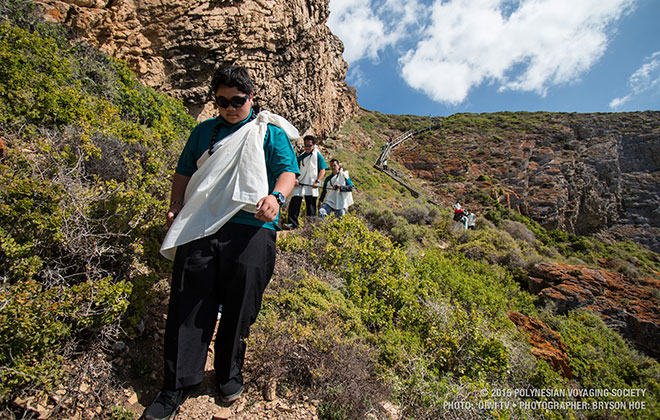Hokule‘a team reaches cradle of civilization

Students from Halau Ku Mana Public Charter School and Kamehameha Schools joined the Hokule‘a crew for a visit to caves at Pinnacle Point in South Africa.
MOSSEL BAY, South Africa » Hokule’a crew members and Hawaiian students came from half a world away to see these rugged seaside caves, considered the origin of modern humanity, and to pay tribute as members of one of the planet’s youngest cultures.
The weighty significance of the caves that the local island group encountered this week at Pinnacle Point, a small stretch of coastline along Mossel Bay, was at times hard to grasp. Every human being alive today is believed to have originated from cave-dwellers who survived an ancient ice age in the area, according to the prevailing research.
But the students and crew did their surroundings justice. During an intimate morning gathering Wednesday, as waves crashed nearby, the mana — the spirit — of Hawaii echoed off the cave walls of Pinnacle Point’s "site 13b."
Students from Halau Ku Mana Public Charter School and Kamehameha Schools solemnly recounted traditional Hawaiian creation stories. They performed hula at the cave’s entrance, facing the sea, as the canoe’s crew silently watched from inside the cavern.
"All of us represented Hawaii in a pono way — in the best way we could represent Hawaii," Halau Ku Mana student Ku’ulei Fujiyama recounted later.
"The feeling is kind of indescribable," Fujiyama’s classmate Lennon Helekahi added. "It’s like a warmth inside. It’s like being home for a long time."
Don't miss out on what's happening!
Stay in touch with breaking news, as it happens, conveniently in your email inbox. It's FREE!
The theme of Hawaiians, representing one of the youngest cultures on earth, experiencing some of the oldest cultures on earth has been constant since the Hokule’a landed in South Africa earlier this month as part of the canoe’s Malama Honua ("Care for the Earth") worldwide voyage. It arises just about everywhere the crew and its delegation from back home go.
In one remarkable moment, during a school visit Monday at the Nyanga township outside Cape Town, hula dancers from the Hawaii schools joined their counterparts from the African Xhosa tribe for a spontaneous performance before hundreds of students.
They danced in rhythm together, despite their cultures being separated by vast distances and time.
Back at Pinnacle Point the visitors from Hawaii felt a connection to the early humans who had lived there. The cave walls and floors have yielded the earliest evidence yet of people crafting tools and art more than 150,000 years ago. Researchers now believe it’s the cradle of symbolic and complex human thought.
Guiding the Hawaii group Wednesday was Peter Nilssen, the South African archaeologist who discovered Pinnacle Point’s significance in 1997 with a colleague while working on an environmental impact assessment for the private golf community that now sits on the cliffs above the caves.
Nilssen described the golf community as a blessing and a curse for the archaeological sites. Had it not been for the golf course, there would not have been the environmental surveys that unearthed the artifacts in those caves. Those artifacts predate the previous earliest sites indicating complex human thought, in Europe and Asia, by some 100,000 years, he said.
Still, the community’s developers were supposed to better secure the cave sites and not build the golf course all the way to the cliff edge, he added. From the caves that sheltered some of the earliest human beings, it’s now possible to see golfers line their tee shots on the cliffs above.
Since Nilssen’s 1997 find, researchers have uncovered 54 heritage sites protected by the state, including at least 15 caves, he said. Some $15 million in excavations have occurred since 2000, and they continue with 40 to 50 scientists involved, he said.
"If you’re interested in Stone Age archaeology, this is the place to be," he added Wednesday. "We’ve got a really rich, long record."
According to Nilssen, the earliest human bones have been found in Ethiopia, dating back approximately 195,000 years. That’s about the same time that an ice age that lasted for around 70,000 years enveloped the planet, he said.
At one point during this period, the human population plummeted to between 3,000 and 10,000 people in various parts of Africa, Nilssen added.
Researchers believe the caves around Mossel Bay offered one of the few habitable oases on the planet during that era, where those early humans could survive by living in harmony with their surroundings.
They could harvest abundant shellfish from those cold, nutrient-rich waters — food that led to better human brain development, Nilssen said. Meanwhile, potatolike plants grew wild in the surrounding hillsides, he added.
The caves also reveal the world’s earliest known traces of what Nilssen called "symbolic" behavior — dozens of pieces of ocher dating back approximately 162,000 years, which early humans ground into powder to create pigments, he said.
The late-’90s findings in Mossel Bay represent a "huge push back in time of our origins" when compared with the previous earliest known findings of human art- and tool-making, Nilssen said.
"We do share common ancestry," he told the Hokule’a crew and students. "Whether we like it or not, we’re part of the same family."
The Hawaii students and Randie Fong, Kamehameha Schools’ executive cultural officer, said they appreciated how vividly Nilssen helped to bring those caves and their ancient inhabitants to life for them.
Fong said, "It was important for us to connect spiritually, ancestrally."



